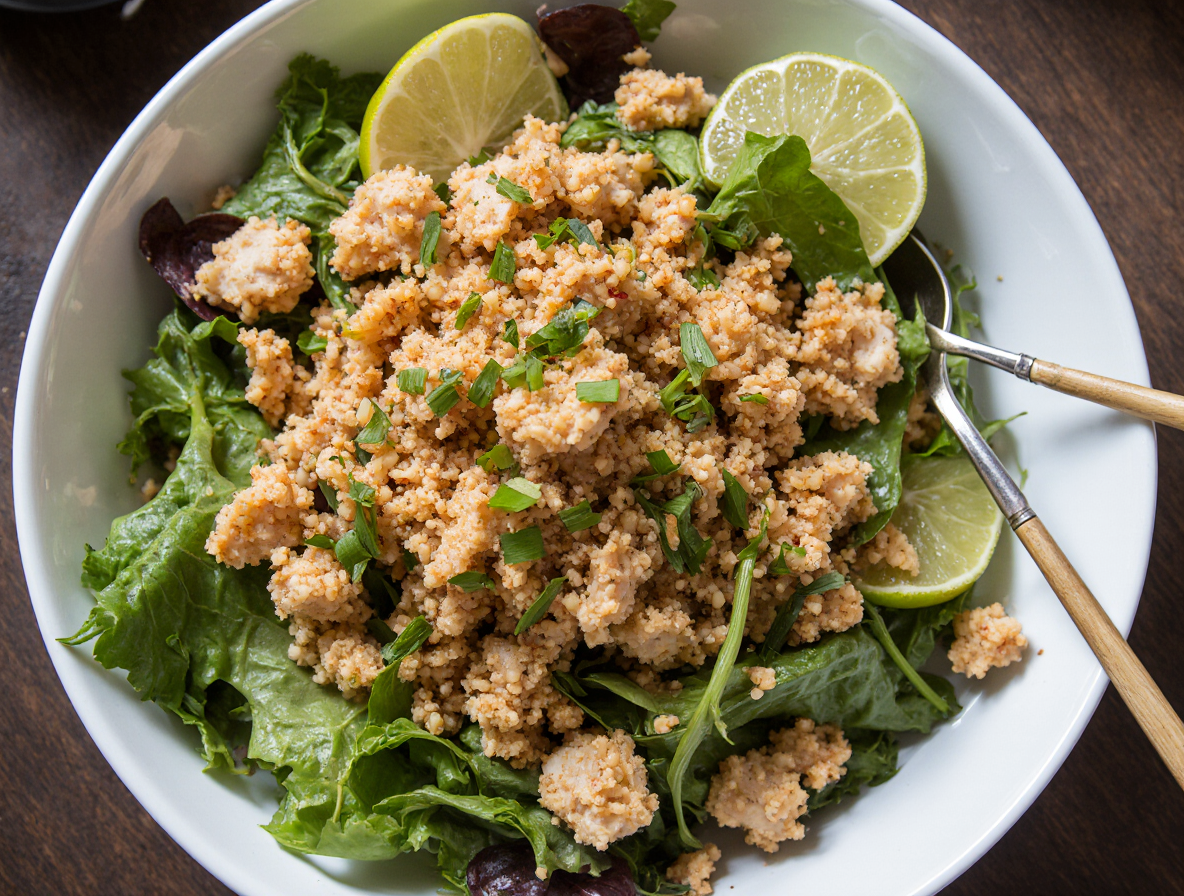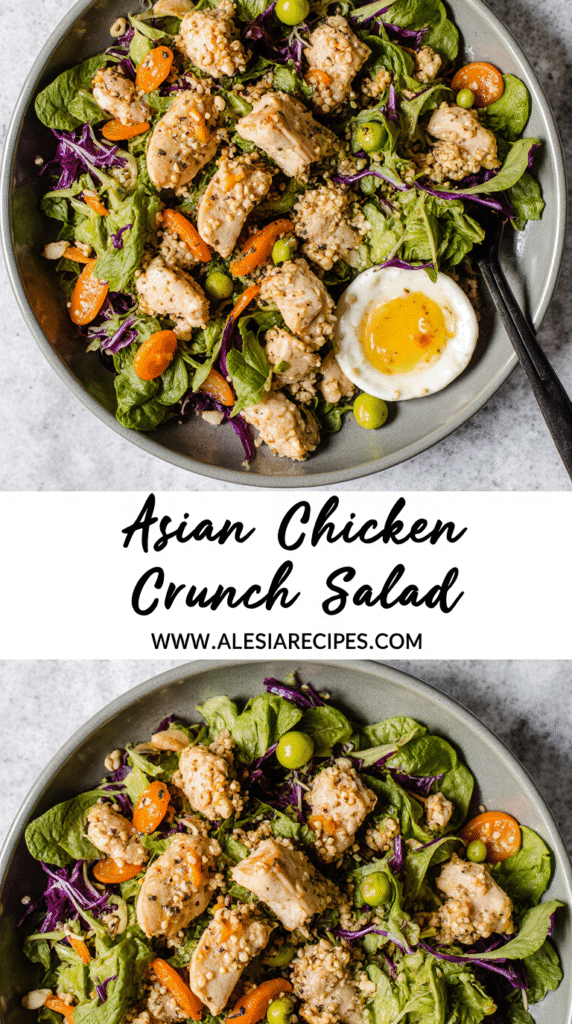How to Make Asian Crunch Salad: A Better-Than-Takeout Recipe
Did you know that uncooked ramen noodles are the secret ingredient that gives asian crunch salad that irresistible texture?
This vibrant dish, which food historians believe originated in California, combines the perfect balance of crunchy, savory, and sweet elements. Our asian chicken salad features a colorful mix of romaine and two types of cabbage, complemented by crisp veggies like carrots and bell peppers. Additionally, the asian crunchy noodle salad gets its distinctive character from ingredients like mandarin oranges, cilantro, and green onions that add incredible flavor depth.
What makes this crunchy asian salad recipe even better? Unlike many dishes that wilt quickly, this one actually holds up remarkably well in the fridge. In fact, you can store it in an airtight container for 3-5 days, making it perfect for meal prep at the beginning of the week. Whether you’re looking for easy lunches or quick dinners, this crunchy asian chicken salad delivers both nutrition and satisfaction.
In this guide, I’ll walk you through creating an asian crunch salad recipe that rivals your favorite restaurant version, with simple ingredients and clear steps that guarantee delicious results every time.
Essential Ingredients for a Crunchy Asian Chicken Salad
The foundation of any memorable asian crunch salad lies in its carefully selected ingredients. A perfect balance of textures and flavors creates that restaurant-quality experience right in your own kitchen.
Cabbage, carrots, and other crunchy veggies
The vibrant base of this salad starts with cabbage – the ultimate crunch provider. I recommend using a combination of green and purple cabbage for both visual appeal and nutritional benefits. Purple cabbage contains powerful antioxidants like anthocyanins and sulforaphane with anti-inflammatory properties. Furthermore, both varieties provide excellent fiber that helps you feel fuller longer.
Carrots add another dimension of crunch along with their natural sweetness and impressive nutritional profile. They’re particularly rich in vitamin A from beta-carotene, essential for healthy vision and immune function. For convenience, pre-shredded carrots work perfectly well.
Other vegetables that enhance your asian crunch salad recipe include:
- Red bell peppers: Adding sweet crispness and vibrant color
- Cucumbers: Providing refreshing crunch with a mild melon aroma
- Edamame: Offering protein and a tender-firm texture
- Bean sprouts: Contributing delicate crunch (consider a quick blanch to reduce raw flavor)
Best proteins to use: chicken, tofu, or shrimp
While the vegetables form the foundation, protein transforms this dish into a complete meal. Rotisserie chicken is perhaps the most convenient option – simply shred or chop it before adding to your crunchy asian chicken salad.
If you prefer a vegetarian approach, edamame beans or tofu make excellent substitutes. Specifically, miso baked tofu creates a flavorful plant-based protein option.
Shrimp deserves special mention as it pairs wonderfully with these asian flavors. One pound (454 grams) of large shrimp, either fresh or quickly thawed from frozen, makes an elegant protein choice. The slightly sweet flavor of shrimp complements the crunchy vegetables beautifully.
Toppings that add texture: nuts, noodles, seeds
The final layer that elevates your asian crunch salad from good to unforgettable comes from the toppings. Nuts provide both crunch and healthy fats – roasted peanuts add a classic flavor, while cashews offer a milder, buttery taste. Almonds, particularly when slivered, contribute wonderful texture.
Crunchy noodle elements are signature additions. Uncooked ramen noodles, broken into pieces, create that irresistible crackle in every bite. Similarly, crispy wonton strips or chow mein noodles provide that authentic restaurant-style finish.
Lastly, don’t overlook seeds. Toasted sesame seeds deliver nutty flavor, whereas sunflower seeds contribute a different kind of crunch. These small additions make a remarkable difference in the overall eating experience.
How to Make the Perfect Asian Crunch Salad
Creating an impressive asian crunch salad requires more than just tossing ingredients together. The secret lies in the sequence and technique of preparation. Let me guide you through each step for restaurant-quality results.
Step 1: Prep and marinate the chicken
Initially, prepare a flavorful marinade by combining soy sauce, olive oil, garlic, sesame oil, and honey in a gallon-sized zip-top bag. For an enhanced flavor profile, consider adding ginger, hoisin sauce, and a touch of sriracha. Place your chicken breasts in the marinade, ensuring they’re fully coated, then refrigerate for at least 30 minutes—though 2-3 hours or even overnight will deliver more robust flavor. For thinner, more evenly marinated pieces, consider butterflying the chicken breasts by cutting them in half lengthwise.
Step 2: Chop and combine the vegetables
For uniform vegetable preparation, you have several options. A mandoline slicer provides the quickest method for achieving even slices. Alternatively, a sharp knife works well, though it requires more time and skill to maintain consistency. For carrots and similar vegetables, a box cheese grater offers efficiency and consistency. Once chopped, combine your cabbages, bell peppers, carrots, edamame, and other vegetables in a large bowl.
Step 3: Cook the chicken and let it cool
Remove the chicken from marinade and cook thoroughly. On the grill, cook at medium-high heat (approximately 400°F) for about 7 minutes per side until the internal temperature reaches 165°F. For oven preparation, bake at 450°F for 13-15 minutes. Subsequently, allow the cooked chicken to rest for 5-10 minutes before slicing. This resting period is crucial for retaining juiciness.
Step 4: Toss everything together
Slice the cooled chicken against the grain into bite-sized pieces. Add it to your vegetable mixture alongside any additional toppings like nuts, seeds, or crunchy noodles. Prior to serving, pour your prepared dressing over the salad and toss thoroughly until all ingredients are evenly coated. For optimal freshness and crunch, serve immediately after adding the dressing.
Making the Dressing: Flavor That Ties It All Together
The dressing is what elevates a simple asian crunch salad into a memorable culinary experience. A well-crafted dressing blends perfectly with the crunchy vegetables and protein, creating harmonious flavors in every bite.
Peanut vs. sesame ginger dressing
Peanut dressing offers a creamy, rich foundation that pairs beautifully with crunchy asian chicken salad. Key ingredients include natural peanut butter, rice vinegar, soy sauce, fresh grated ginger, and toasted sesame oil. For proper consistency, start with ¼ cup water, adding more as needed until the dressing becomes smooth and pourable.
Alternatively, sesame ginger dressing delivers a lighter profile while maintaining complex flavors. This version typically combines olive oil, rice vinegar, sesame oil, soy sauce, lime juice, and fresh ginger. Toasted sesame seeds add the finishing touch, enhancing both flavor and visual appeal.
How to balance sweet, salty, and tangy
Achieving perfect balance requires attention to each flavor component:
- Sweet: Honey or maple syrup (typically 1-3 tablespoons) smooths out acidity
- Salty: Low-sodium soy sauce provides umami without overwhelming
- Tangy: Fresh lime juice and rice vinegar create brightness
- Nutty: Toasted sesame oil adds depth (use sparingly as it’s potent)
Tips for emulsifying your dressing
Proper emulsification prevents separation, ensuring your asian crunch salad recipe maintains consistent flavor. Dijon mustard, honey, and even garlic paste serve as excellent natural emulsifiers. For best results:
- Combine all non-oil ingredients first
- Slowly drizzle oil while whisking vigorously
- Use an immersion blender for foolproof results
Store leftover dressing in an airtight container for up to 1 week, shaking well before each use.
Customizations, Storage, and Meal Prep Tips
Personalizing your asian crunch salad to suit dietary needs and preparing it ahead of time can transform this dish into a versatile meal option for any occasion.
Ingredient swaps for dietary needs
For gluten-free diets, replace soy sauce with coconut aminos and skip the chow mein noodles. Individuals with nut allergies can substitute peanut butter in the dressing with almond, cashew, or sunflower seed butter. Vegetarians might prefer leaving out chicken and adding edamame or tofu instead. Cabbage varieties are highly interchangeable—try Napa, green, red, or even swap for romaine or iceberg lettuce if cabbage isn’t your preference.
How to store without losing crunch
The key to maintaining crispness lies in proper storage techniques. Consequently, always store dressing separately from other ingredients. For optimal freshness, line containers with paper towels when storing leafy greens—this absorbs excess moisture that causes wilting. Hard-sided containers protect delicate ingredients better than plastic bags. Properly stored, asian crunch salad components remain fresh for up to 4-5 days.
Make-ahead tips for busy weeks
Meal prep success comes from strategic assembly. Chop all vegetables up to one day in advance. Store components in separate airtight containers with dates labeled. For grab-and-go lunches, try the mason jar method—dressing at the bottom, followed by hearty vegetables, proteins, and delicate greens on top. This salad works exceptionally well for meal prep since many components actually improve with time as flavors meld. Regardless of your schedule, this crunchy asian chicken salad remains ready whenever you are!
Conclusion
Asian crunch salad truly stands out as a versatile, delicious dish you can easily make at home. The perfect combination of crunchy vegetables, protein-rich additions, and flavorful dressings creates a meal that rivals any restaurant version. Most importantly, this salad offers endless possibilities for customization based on your dietary preferences and available ingredients.
The secret to an exceptional asian crunch salad lies in its layers of texture. Crisp cabbage, colorful vegetables, tender protein, and those irresistible crunchy toppings work together to create a satisfying eating experience. Additionally, the homemade dressing ties everything together with its balanced sweet, salty, and tangy notes.
Making this salad at home allows you complete control over ingredients and portions. Therefore, you can adjust flavors to suit your taste preferences while ensuring freshness and quality. The meal prep benefits make this salad even more appealing for busy weeks – simply store components separately and assemble when ready to eat.
What makes this recipe particularly special is its ability to maintain freshness and crunch for several days. Unlike many salads that quickly wilt, this one actually improves as flavors meld together. Consequently, you’ll have delicious, nutritious meals ready throughout the week with minimal effort.
Whether you choose chicken, tofu, or shrimp as your protein, whether you prefer peanut or sesame ginger dressing, this asian crunch salad delivers exceptional flavor and nutrition. So grab your ingredients, follow these simple steps, and enjoy a better-than-takeout asian crunch salad right at home!
FAQs
Q1. What gives Asian Crunch Salad its signature texture? The signature crunch in Asian Crunch Salad comes from a variety of ingredients, including cabbage, carrots, bell peppers, and uncooked ramen noodles or crispy wonton strips. Nuts and seeds like peanuts, cashews, or sesame seeds also contribute to the satisfying texture.
Q2. What are the key components of an Asian Crunch Salad? An Asian Crunch Salad typically includes a mix of shredded cabbage, carrots, bell peppers, and proteins like chicken or tofu. It’s often topped with crunchy elements such as nuts or crispy noodles and dressed with a flavorful Asian-inspired dressing, such as peanut or sesame ginger.
Q3. How can I customize the salad for dietary restrictions? You can easily adapt the salad for various dietary needs. For gluten-free diets, use coconut aminos instead of soy sauce and skip the chow mein noodles. For nut allergies, substitute peanut butter with seed butter in the dressing. Vegetarians can replace chicken with edamame or tofu for protein.
Q4. How long can I store Asian Crunch Salad? When stored properly, the components of Asian Crunch Salad can remain fresh for up to 4-5 days. To maintain crispness, store the dressing separately from other ingredients and use hard-sided containers. For leafy greens, line containers with paper towels to absorb excess moisture.
Q5. What types of dressing work best for Asian Crunch Salad? Two popular dressing options for Asian Crunch Salad are peanut dressing and sesame ginger dressing. The peanut dressing offers a creamy, rich flavor, while the sesame ginger dressing provides a lighter profile. Both dressings typically balance sweet, salty, and tangy flavors to complement the crunchy vegetables and protein in the salad.


